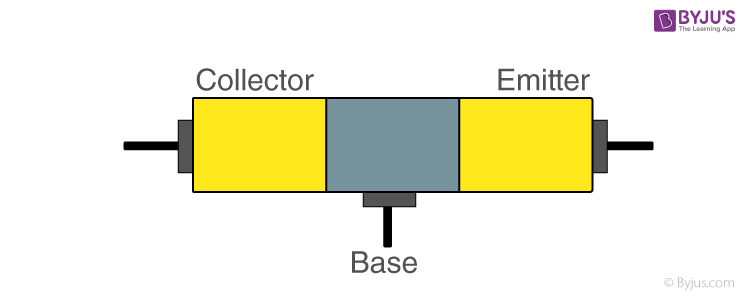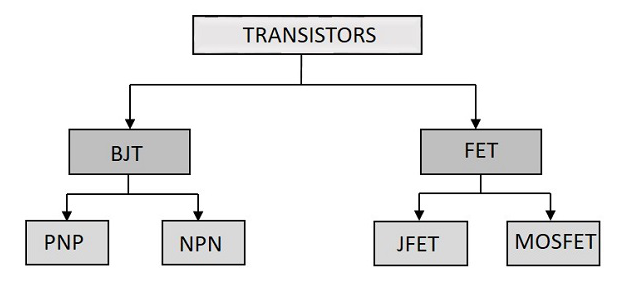Transistor TerminalsTypes of TransistorsApplications of Transistor
A human brain contains 100 billion cells that let us think and remember things. Likewise, a computer contains billions of miniature cells known as transistors. It is a semiconductor device made of silicon, a chemical compound commonly found in sand. Transistors have revolutionized the electronic industries since they were first invented. It was invented by John Bardeen, Walter Houser Brattain, and William Shockley in 1947. In this article, we will discuss transistors in detail.
What is a Transistor?
A transistor is an electronic component that is used in circuits to either amplify or switch electrical signals or power, allowing it to be used in a wide array of electronic devices. A transistor consists of two PN diodes connected back to back. It has three terminals namely emitter, base and collector. The basic idea behind a transistor is that it lets you control the flow of current through one channel by varying the intensity of a much smaller current that’s flowing through a second channel.

A transistor is a semiconductor device with three terminals, capable of amplification and rectification.
More articles on Transistor
- Types of Transistors
- Uses Of Transistor
- Transistor Characteristics
- Bipolar Junction Transistor
- Junction Transistor
Terminals of Transistor
As discussed in the previous section, a transistor is composed of three terminals: emitter, collector, and base. In this section, we discuss the functionalities of each terminal in detail.
The base serves as a gate controller device for a larger electric supply. The collector is a larger electrical supply and the outlet of that supply is the emitter. The current flowing through the gate from the collector can be regulated by sending varying levels of current from the base. In this manner, a very small amount of current can be used to control a large amount of current like in amplifiers. Transistor works as a switch or as an amplifier.
Physical Characteristics of Terminals
|
|
| Emitter – This segment is on the left side of the transistor. It is moderately sized and heavily doped.
Base – This segment is at the center of the transistor. It is thin and lightly doped. Collector – This segment is on the right side of the transistor. It is larger than the emitter and is moderately doped. |
- Base-emitter junction is forward biased
– There is a flow of electrons (holes) from the emitter to base and holes (electrons)from the base to emitter; however since the concentration of emitter electrons (holes) are greater than the base holes (electrons), this current is primarily made of electrons (holes)
– These emitter electrons (holes) become minority carriers in the base; however, since the base is narrow very little electron-hole recombination occurs in the base and these electrons (holes) are drawn towards the collector-base junction
- Collector-base junction is reverse biased
When these emitter electrons (holes) reach the collector-base junction, they are pulled across the junction into the collector by the electric field due to the depletion region ions.
Different Types of Transistors and their Applications
There are many types of transistors and each transistor specializes in its application. But, the main classification of transistors is as follows:

In the next few sections, let us study these transistors in detail.
Bipolar Junction Transistor
A bipolar junction transistor, shortly termed as BJT is a current controlled device that consists of two PN junction for its function. It is configured in two ways as NPN and PNP. Among the two, NPN transistor is the most preferred for the sake of convenience. The NPN transistor is made by placing a p-type material between two n-type materials. Likewise, the PNP transistor is made by placing an n-type material between two p-type materials.
Field Effect Transistor
A field-effect transistor shortly termed as FET is a voltage-controlled device, unlike BJT which is a current controlled device. The FET is a unipolar device, which means that it is made using either p-type or n-type material as the main substrate. One of the many of its advantages is that it has a very high input impedance, which is in the order of Mega Ohms. It has many other advantages such as low heat dissipation and low power consumption.
Bipolar Junction Transistor vs Field Effect Transistor
Now, let us look at the various differences between BJT and FET
|
Bipolar Junction Transistor |
Field Effect Transistor |
|
It is a bipolar device |
It is a unipolar device |
|
It is a current-driven device |
It is a voltage-driven device |
| Low input impedance |
High input impedance |
| Low noise level |
High noise level |
| Less thermal stability |
Better thermal stability |
Transistor as an Amplifier and a Switch
Transistor as an amplifier serves as an energy booster. It comes in useful things like hearing aids, which is one of the prior gadgets people use for a transistor. Hearing aids consist of a tiny microphone that picks up sounds for your world and converts them into varying electric currents. Microphones are also fed into a transistor that boosts a tiny loudspeaker, and you hear a much louder version of sound around you.
Transistors also work as switches. A small electric current flowing through one part of a transistor can make a much larger current flow through the other part. This is how all computer chips work. For instance, a memory chip includes hundreds of transistors, each of which can be switched on or off individually. Since every transistor can be in two separate states, it can store two numbers zero and one separately. A chip can store billions of zeros and ones with billions of transistors and as many letters and numbers.
Learn more about this concept by visiting the link: Transistor as a device – Switch and Amplifier
Applications of Transistor
Semi-conducting materials make the working of transistor possible. Most of you must be familiar with electrically conductive and non-conductive materials. Metals are typically considered to be conductive. Things like plastics, wood, ceramics, and glass are insulators, or non-conductive. A team of scientists discovered how to test certain types of crystals and utilize them as electronic control devices by exploiting their semi-conductive properties.
Heat-operated switch
- A thermistor is one of the most important components in the circuit of a heat-operated switch. It is a kind of resistor that responds to the surrounding temperature. Its resistance decreases when the temperature is high and vice versa.
- The thermistor resistance drops and a higher share of the supply voltage are dropped across R when the heat is applied to the thermistor. The base current rises followed by an increase in collector current. As a result, the bulb glows and siren sounds.
- These particular circuits are mainly used in the fire alarm system.
Integrated Circuits
- Integrated circuits consist of resistors, transistors, diodes, and capacitors combined with a silicon wafer-thin chip, known as the microchip.
- Integrated circuits consume less electrical energy, occupy a small space that reduces the circuit’s size, and can be built at a low cost.
Frequently Asked Questions – FAQs
Who invented the transistor?
What is a transistor?
What are the three terminals of the transistor?
State true or false: field effect transistor is a unipolar device.
What is a bipolar junction transistor?
Stay tuned to BYJU’S and Keep Falling in Love with Learning!

Concise content! Thank you so much!